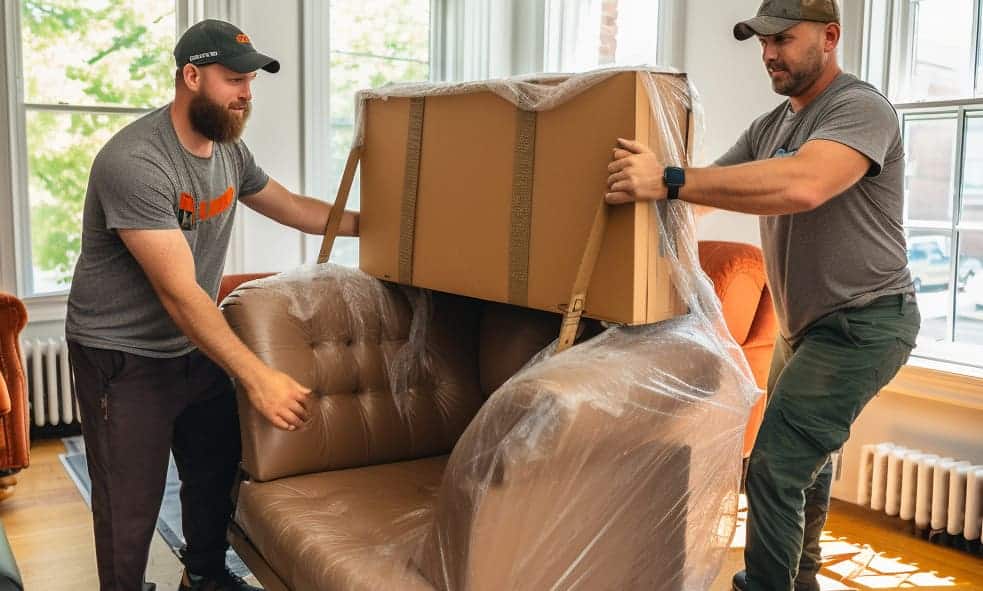Moving heavy furniture, whether because you are relocating to a new home or rearranging your living space, can be challenging, primarily because of the sheer bulk and weight, which can make the process seem impossible.

However, with some ingenuity and sound techniques, you can make moving heavy furniture much more manageable and less stressful.
This blog post will explore six tips and tricks to help you easily move heavy furniture.
In This Article
1. Plan and Prepare
A solid strategy and careful planning are the cornerstones of moving heavy furniture successfully because it saves you from unnecessary headaches and physical strain.
To begin with, closely inspect the furniture you want to move and your immediate surroundings. Measure doorways, hallways, and tight corners to ensure your furniture can move through them easily. If the furniture piece you want to move is too big, consider temporarily removing doors or hinges to create additional space.
You can also take things a bit further and use virtual staging software and apps to visualize your new furniture arrangement. Doing this provides a visual guide and a clear vision of where to place each furniture piece after moving. Consequently, it minimizes the need for unplanned, strenuous lifting and guarantees that the heavy furniture pieces seamlessly find their designated spots.
2. Use the Right Tools
Another thing you can do to make moving heavy furniture easier is to ensure you have all the essential equipment, including furniture sliders, moving straps, a sturdy dolly, and durable gloves.
Furniture sliders, for example, are lifesavers when moving heavy pieces. Invest in high-quality ones, often made of hard plastic or felt, which reduces friction and makes sliding heavy furniture across the floor a breeze.
Alternatively, a furniture dolly equipped with straps can simplify the moving process, especially for bigger and bulkier items. These dollies have straps that you can cinch around the furniture, securing it during transport. This added security ensures your furniture remains stable and prevents it from shifting or tipping over during the move.
Using the right moving tools streamlines the process and makes moving heavy furniture more manageable and safe.
3. Clear the Path
Clearing your travel path is one of the most fundamental things you can do when moving heavy furniture to prevent accidents and damage.
Start by meticulously removing any obstructions that might become potential tripping hazards, such as rugs, small objects, or low-hanging decorations. Creating a wide, unobstructed pathway ensures you can comfortably maneuver yourself and the heavy furniture.
Equally important is protecting your floors. You can mitigate the risk of scratches or damage during the move by placing old rugs, cardboard, or moving blankets along the pathway.
This cost-saving measure can help control your moving costs and save you from expensive repairs.
4. Use Proper Lifting Techniques
Using proper lifting techniques is another key tip you cannot overlook when moving heavy furniture.
Here is the lifting technique you should use to prevent injuries:
- Stand as close to the furniture as possible.
- Bend your knees, not your back.
- Keep your back straight and your core engaged.
- Firmly grip the furniture by the handles or a secure frame part.
- Lift with your legs while pushing up from your heels.
- Keep the furniture close to your body as you lift.
- Take small steps when moving and pivot with your feet rather than twisting your back.
Remember to communicate with your helpers if you’re working with others to ensure everyone lifts and moves in sync.
5. Disassemble for Easier Transport
Please dismantle larger furniture pieces, such as beds, tables, and bookshelves, to make moving and transporting them significantly easier and more manageable. The easiest way to do this is to identify screws, bolts, or other fasteners that hold the furniture together.
It’s essential to stay organized throughout this process, keeping track of every piece of hardware you remove. Storing these components in a labeled bag or container ensures nothing gets lost during the move. Taking photographs during disassembly can also be a valuable reference point during reassembly.
6. Teamwork Makes the Dream Work
Sometimes, you can ask family, friends, or neighbors to help you move heavy furniture. Having an extra set of hands lowers the physical strain and adds an element of safety.
If you would rather relocate furniture effortlessly without troubling yourself, your friends, and your family or taking any chances, consider using moving apps to find a moving team that can do the work for you as you sit back.
These applications are a great way to find a professional moving team experienced in moving heavy furniture, get estimates, and easily schedule the move.
Conclusion
Moving heavy furniture doesn’t have to be a stressful or back-breaking experience. The six tips and tricks we have discussed will help you confidently tackle the challenge of moving heavy furniture. Happy moving!






